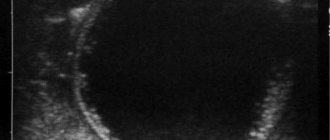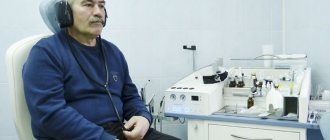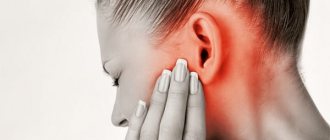Causes Symptoms of otosclerosis Diagnosis Treatment of otosclerosis
Otosclerosis is a pathology of the middle and inner ear associated with the appearance of bone tissue in the area of attachment of the stapes (the third, innermost auditory ossicle) to the oval window of the vestibule (the border of the middle and inner ear), as well as with the growth of the bone plates of the cochlea and semicircular canals. Otosclerosis occurs most often in women of childbearing age.
Otosclerosis in the area of connection of the stapes with the oval window leads to disruption of the sequential transmission of sound waves to the cochlea - this is how sound transmission pathology develops. Bone growths in the cochlea interfere with the normal perception of sounds by the nerve endings of the auditory nerve - this is a pathology of sound perception or sensorineural hearing loss. When the semicircular canals are affected by otosclerosis, vestibular disorders develop (dizziness, nausea, unsteady gait, difficulty maintaining balance with a sudden change in body position).
Symptoms of otosclerosis
The main danger is the long asymptomatic period of otosclerosis. Imperceptible and gradual changes in the bone capsule can occur over 2-3 years, manifesting themselves only as a slight noise in the affected ear. At this stage of development of otosclerosis, changes can be detected during a routine examination by an otolaryngologist, during which audiometry is performed.
As the disease progresses and there is no treatment, the symptoms of otosclerosis appear as follows:
- Impaired perception of low frequencies while maintaining perception of high frequencies. In some cases, the sensitivity of the sound-receiving apparatus to high frequencies even increases. At this stage, patients complain of problems with understanding male speech, although the speech of children and women retains its clarity and clarity for them.
- Improving hearing acuity in noisy environments. This symptom is a subjective sensation of the patient, who mistakes the natural increase in the volume of speech of the interlocutor, who is trying to speak louder in a noisy environment, as an improvement in hearing.
- Violations of the functions of the sound-receiving apparatus leads to the fact that the simultaneous entry into the cochlea of sounds from the external environment and acoustic waves transmitted through the soft tissues of the body impairs the perception of the former. Thus, a person may complain that when he moves, chews food, etc., his understanding of the interlocutor’s speech deteriorates significantly.
- As the disease progresses, the above-described symptoms “smooth out” - the perception of both low and high frequencies deteriorates, and the understanding of the interlocutor speaking in a whisper or in a full voice becomes approximately equivalent.
- One of the characteristic features of otosclerosis is the constant regression of hearing. Unlike a number of other diseases in which there is a periodic decrease or increase in hearing acuity, this does not happen with otosclerosis.
- Noise in the affected ear. This symptom is present in the overwhelming majority of patients with otosclerosis and is described by them as “rustling”, “white noise”.
- In addition to hearing disorders, patients with otosclerosis may develop neurotic disorders. The limitation in communication imposed by hearing loss leads to a decrease in a person’s social activity, which can cause him to become withdrawn and cause mood swings. Often, patients develop sleep disturbances caused by constant tinnitus.
Regardless of the causes of the disease and its manifestations, treatment of otosclerosis should begin as early as possible in order to prevent unwanted changes not only in the hearing organs, but also in the state of the nervous system.
Forms of the disease
There are several forms of otosclerosis:
- conductive - a violation of the conductivity of sound waves, amenable to surgical correction up to the restoration of hearing;
- mixed - not only the conduction function is disrupted, but also the auditory analyzer, and can be partially restored by acoustic perception;
- Cochlear otosclerosis is a complete loss of sound perception that cannot be corrected surgically.
The disease can develop at different rates - slowly, spasmodically and quickly.
Causes
The exact mechanisms of development of this disease are currently unknown. But the most likely causes of otosclerosis include the following factors:
- Hereditary predisposition. According to various estimates, from 27 to 40% of all patients diagnosed with otosclerosis have a family history of cases of this disease in relatives of the previous generation. In addition, many patients have genetic defects of various types.
- Endocrine and metabolic disorders. This hypothesis is supported by the fact that in women suffering from otosclerosis, deterioration is observed during pregnancy.
- Risk factors that increase the likelihood of developing otosclerosis include infectious diseases (in particular, measles), persistent acoustic injuries (working in conditions of industrial noise without the use of protective headphones, etc.), as well as vascular diseases, in which the blood supply to the tissues of the inner ear is disrupted.
The general state of health, as many researchers believe, is indirectly related to the development of otosclerosis. Without being the direct cause of this disease, any health disorder (a previous cold, severe stress, chronic gastrointestinal diseases, etc.) can activate the mechanisms directly responsible for the development of the disease. This theory deserves attention, especially from the point of view of patients with unfavorable heredity. So, if there are cases of otosclerosis in the family history, regular preventive examinations by an otolaryngologist and other specialists are a measure for the timely detection of the disease.
– How is the operation - stapedoplasty? How do patients tolerate the intervention?
The operation is considered microsurgical and high-tech. It is passed through a funnel under a microscope. The operation is performed under local anesthesia: we inject the ear into the ear canal - this is the only painful sensation. The surgical intervention lasts about 1 hour. Before the operation, we provide premedication: we administer sedatives and painkillers intravenously. As a rule, patients are half asleep after this. But after an operation under local anesthesia, a person can immediately evaluate the result: he suddenly begins to hear everything, which has enormous psychological significance for both the patient and the surgeon.
Classification of otosclerosis
Treatment of otosclerosis and its manifestations largely depend on the form of the disease. This pathology is usually classified depending on the type of impairment of sound perception and sound conduction:
Conductive otosclerosis.
In this form of the disease, only a violation of sound conduction is observed, which developed under the influence of the proliferation of bone tissue and a decrease in the mobility of the stapes. Treatment of this type of otosclerosis is one of the most favorable in terms of prognosis, as it allows you to restore the functions of the inner ear.
Cochlear otosclerosis.
This form of the disease is characterized by a progressive deterioration in sound perception. Surgical treatment of cochlear otosclerosis may be ineffective, especially if you consult a doctor late in the course of the disease. H3: Mixed otosclerosis.
This form of the disease combines the two previous ones - a decrease in hearing acuity is caused by both a violation of sound conduction and its perception. Treatment for this form allows the functions of the inner ear to be restored to a certain extent (to the level of bone conduction).
Treatment tactics are determined by the individual characteristics of the clinical case and the appropriateness of prescribing a particular method.
Depending on the causes of the disease (identified or suspected), reducing the rate of disease progression and treating otosclerosis can be carried out using a complex of medications.
Before and After Results
Next, we present several tone threshold audiograms of patients before and after surgery.
Audiogram of the patient before surgery on the left ear. The right ear was operated on 7 months ago. The pure-tone threshold audiogram shows conductive hearing loss of the second degree in the left ear (WHO) with the presence of a Carhart wave.
Audiogram of the same patient 15 days after piston stepoplasty
Audiogram of the patient before surgery. The tone threshold audiogram shows conductive hearing loss of the first degree in the left ear, mixed hearing loss of the fourth degree in the right ear (WHO). The first to be operated on is the worse hearing ear – the right ear.
Audiogram of the same patient 12 days after piston stepoplasty on the right ear
Treatment of otosclerosis
At the Research Clinical Institute of Otolaryngology named after. L.I. Sverzhevsky uses both innovative and classical methods of treating otosclerosis.
The survey uses a wide range of tools and methods aimed at obtaining detailed information regarding the severity of changes. Among them:
- otoscopy;
- microotoscopy;
- audiometry;
- study with a tuning fork;
- acoustic impedance measurement;
- indirect otolitometry;
- vestibulometry;
- CT scan of the brain;
- X-ray examination of skull bones, etc.
A preliminary comprehensive examination allows you to identify and evaluate all the features of the clinical picture, and create an individual treatment program that is most effective in each specific case.
To make an initial appointment and draw up a diagnostic plan, call 633-99-60.
– What should a patient be prepared for during the rehabilitation period?
Stapedoplasty surgery is associated with some limitations. Since we open the inner ear (and it contains receptors not only for the auditory, but also for the vestibular analyzers), patients may experience severe dizziness after surgery. Therefore, for a month we recommend avoiding loud noises, lifting heavy objects, driving a car or taking the subway. You can't fly on an airplane for another 3 months. A person stays in the hospital for 7-8 days, and then he is under outpatient observation for 3 weeks, during which time he is issued a sick leave certificate. Further recommendations depend on the nature of the patient’s activity.
To make an accurate diagnosis, use:
- audiometry;
- tuning fork study (identifying the difference in the sensation of sound vibrations through air and directly through tissue);
- diagnostics of sensitivity threshold to ultrasound;
- radiography (detection of pathologies of the auditory bones);
- MRI. With high detail from different projections, the condition and mobility of the auditory bones are assessed, the presence of inflammation and other changes in bone or connective tissue is revealed.
Types of Hearing Damage
The outer and middle ears transmit sound; the inner ear perceives it. If there is isolated damage to the outer or middle ear, we are talking about conductive (transmission) hearing loss (hearing loss). If the disorder is associated with the inner ear, we are talking about sensorineural hearing loss, or cochlear neuritis. In cases where both the middle and inner ears are damaged, they speak of a mixed form of hearing loss.
Otosclerosis is an osteodystrophy of the temporal bone affecting the capsule of the labyrinth. More often it leads to fixation of the stapes, but can also lead to damage to the cochlea and other parts of the labyrinth. The etiology of the disease is unknown. Otosclerosis is a progressive disease that usually appears at a young age. Sometimes it is detected in very young people, more often in women. There are family cases. The risk of a child developing otosclerosis if one of the parents has the disease is 1 in 4. Hearing loss progresses to almost complete deafness; in more severe cases, sensorineural hearing loss predominates. The disease is usually bilateral.
Read also
Chronic laryngitis
Understanding Chronic Laryngitis Chronic laryngitis occurs when the larynx and its vocal cords become inflamed, swollen and irritated due to prolonged exposure to external factors.
This is quite... Read more
Hoarseness of voice
What is Hoarseness Hoarseness is an abnormal change in voice that is a common symptom that often occurs in combination with a dry or scratchy throat. If your voice is hoarse...
More details
Otitis
What is otitis? Otitis is an ear disease in which inflammation develops, often with the formation of pus. It is provoked by infections that attack the body due to hypothermia, water getting into the ear or...
More details
Earache
Ear pain is common among children, but it can also affect adults. Ear pain in adults and children can affect both one or both ears, but most often it is a one-sided process. Symptoms...
More details
Runny nose
What is a runny nose? A runny nose is an excessive secretion of mucus from the nasal cavity, caused by its inflammation. The manifestations of a runny nose can range from clear fluid to thick mucus. Source...
More details










